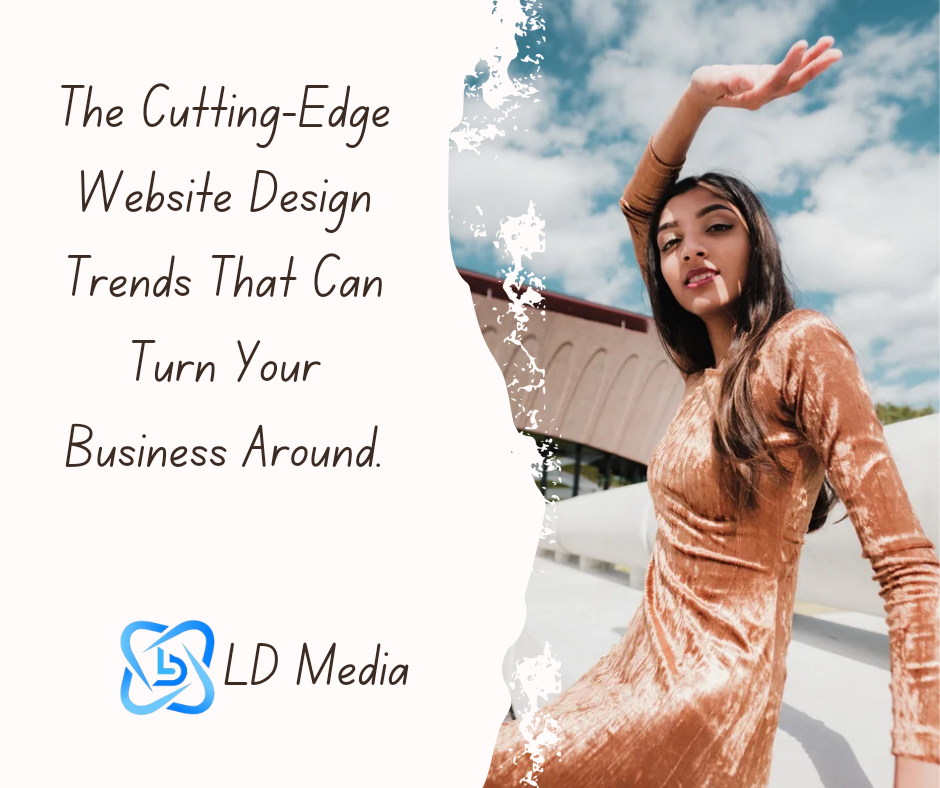Introduction

In today’s digital age, a well-designed website is crucial for the growth and success of any business. Imagine having a website that not only represents your business, but also captivates your audience, generates leads, and boosts conversions. As technology continues to evolve, so do the trends in website design which should not be overlooked when designing your business website. So, by staying up-to-date with the latest website design trends, you can revolutionize your business and create a website that stands out from the crowd.
In this article, I will explore some cutting-edge website design trends that are shaping the online landscape. These trends are simple but powerful design techniques that make the change in today’s website design business and applying all or some of these design trends will help you to achieve website goals.
The Design Trends
As a website designer who has worked with many businesses in different sectors, I have monitored the effects of these design techniques on the conversion rate of the websites. They are very effective in helping website owners to achieve their business goals and assert strong online footprints. Also, they increase visitors’ engagement on your website, thereby increasing visibility and ranking. The nine techniques I will list below are the ones that top for me which I also use when designing websites for clients according to the goals of the websites.
Remember, a cutting-edge website design not only attracts attention but also drives engagement, boosts conversions, and takes your business to new heights.

1. Simplicity
A well-designed website should be devoid of ambiguity. When crafting your business website, the main focus should be to keep it as simple as possible. This is a website design trend that cannot age out.
In a common voice, “less is more.” Simplicity is key in the world of website design. This is known as minimalism. Minimalistic designs have gained immense popularity in recent years. By stripping away unnecessary elements, minimalistic designs provide a clean and clutter-free user experience. A minimalist website does not only look visually appealing but also improves user experience and functionality. This also means that your website visitors can easily navigate your website and easily find what they are looking for. When this is not the case with your website, visitors leave too early and may not return. With fewer distractions, users can focus on the core message of your business and take the desired actions.
ALSO READ THE 7 Expert Tips for Securing the Perfect Domain Name for Your Business.
2. White Space
White space, also known as negative space, refers to the empty areas surrounding website elements. Embracing white space creates a sense of breathing room for your content and allows it to stand out. It provides visual clarity and helps guide users’ attention to the most important parts of your website. The strategic use of white space can enhance the overall aesthetic appeal and user experience of your website. When creating elements in your website, normalise the use of appropriate padding units. In doing this, it is important to have balance; not too much or too small white space. The key thing is to give your website elements some breathing space.
3. Hero Images and Videos
In meeting new people, it is said that first impressions matter. This is the same for your website. In website design, first impressions matter, and what better way can you make a strong impact than through captivating visuals? Hero images and videos are those large and attention-grabbing elements placed prominently on the homepage. These visually appealing assets instantly communicate your brand, products, or services. High-quality images and videos not only engage your audience but also create a memorable experience that sets your business apart.
Sourcing for royalty-free images and videos is another task when designing your website. But, there are now many online design tools where you can get quality visually appealing images and videos. To get copyright-free photos and videos you can use for your website, Pexels and Pixabay come in handy. You can download as many royalty-free elements as you need.
4. Parallax Scrolling
This is one website design technique that brings special and aesthetic visual effects to your website. Parallax scrolling creates an illusion of depth by moving background and foreground elements at different speeds. This visually stunning effect adds a dynamic and interactive element to your website because as users scroll, the layers of your website come to life, creating an engaging and immersive experience. Parallax scrolling can be used to tell a story, showcase products, or guide users through your content in a unique and captivating way.
5. Micro-interactions
In website design, micro-interactions are those subtle animations or feedback that respond to user actions. They add a touch of interactivity or kinetic communication flavour, making the user experience more engaging and enjoyable. By micro-interaction, I mean those hover effects, animated buttons and motion texts. They can make your website feel alive and responsive. Therefore, by incorporating these small, delightful details, you can create a memorable experience that leaves a lasting impression on your users. They also improve user experience by giving mild direction to your website users.

6. Mobile-First Design and Responsive Layouts
The mobile-first era in website design advocates prioritising mobile phone usage in your design. Most people who access the internet do so through their smartphones. Therefore, while building your website, you should focus on giving it a more mobile-friendly outlook.
According to recent statistics,
- Over 55% of website traffic comes from mobile devices.
- 92.3% of internet users access the internet using a mobile phone.
- There are approximately 4.32 billion active mobile internet users.
With the increasing use of smartphones, mobile browsing has surpassed desktop usage.
As a result, businesses must prioritize mobile-first design to ensure their websites are optimised for smaller screens. Mobile-first design involves creating a website with mobile users in mind and then scaling it up for larger screens. By adopting a responsive layout, your website will automatically adapt to different screen sizes, providing a seamless and consistent experience across devices. This technique in designing your website is as important as having the website itself.
This is a follow-up technique to the mobile-first trend geared towards improving the user experience of customers visiting your website through their mobile phones. One of the challenges of mobile browsing is limited screen space. To overcome this, thumb-friendly navigation has become a popular trend which you will have to place at the forefront design features needed to achieve your online goals.
Placing navigation elements within easy reach of the user’s thumb allows for effortless navigation on mobile devices. Preferably, always place the navigation knobs on the user’s right side for the right thumb to easily reach, and, it should not be blocked or conflict with other elements of the website. Whether through sticky navigation menus, hamburger menus, or bottom navigation bars, optimising your website for mobile navigation ensures an intuitive and user-friendly experience.
8. Tailored User Experience
In today’s digital landscape, customisation is key. Users expect personalised experiences that cater to their individual needs. By customisation here, I mean that you should place some elements on your website that the visitors can relate to based on what they are looking for, where they belong, their social status, their previous choices or preferences, and so on. You can create a tailored experience for every visitor by leveraging user data and employing available smart algorithms which can be generated using digital tools. This can be through recommending products based on past purchases or displaying content based on user preferences. Customisation or personalisation adds value and fosters a deeper connection with your audience. In building and running your website successfully this 2024 and beyond, consider making this trend a priority.
9. Custom Illustrations, Images and Animations
Stock images can be found on countless websites like the ones I have recommended above, often diluting the uniqueness of a brand if indiscriminately used. To stand out, businesses are turning to custom illustrations, images and animations. These bespoke visuals not only add personality and style to your website but also help tell your brand’s story more authentically. Custom illustrations and animations allow you to differentiate yourself from competitors and leave a lasting impression on your visitors.
Conclusion
In the ever-evolving world of website design, staying ahead of the curve is essential for businesses looking to have a great online presence experience. By embracing minimalistic designs, captivating visuals, and interactive elements, you can enhance user experience and make a memorable impact. Additionally, prioritising mobile-first design and personalisation ensures your website caters to the modern user’s needs. Remember, a cutting-edge website design attracts attention, drives engagement, boosts conversions, and takes your business to new heights. So, why wait? Upgrade your business today with a well-designed website, and unlock the true potential of your business.
Reach out to LD MEDIA TEAM now let’s design and manage the website that will stand out your business.
Let’s hear your opinion about this article. Drop your comment in the comment box below. Share this post on your social media handles.


